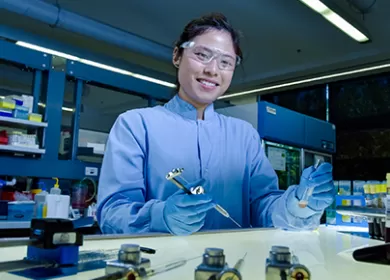Blood of the future
Have you ever wondered if we could grow blood outside the body? It’s an exciting prospect, with incredible potential. That’s why some of the smartest minds at Lifeblood are working hard to make it a reality, but it doesn’t come without its challenges. Let’s dive into the world of lab-grown blood, explore the technology that makes it possible, and take a glimpse at the potential future of blood donations.
Research takes a leap forward
Lifeblood’s research into lab-grown red blood cells is directed by Dr. Becky Griffiths. Becky moved to Australia from the UK in 2020 to become a Senior Research Fellow at Lifeblood, but her work with lab-grown blood began over 10 years ago. In the body, red blood cells grow and develop in your bone marrow, which contains a special mix of growth factors that stimulate the growth of stem cells into specialised cells. To replicate this environment in the laboratory, Becky used the buffy coat by-product from platelet donations which contains stem cells. To coax these isolated stem cells to mature into red blood cells, she also needed to recreate the cocktail of growth factors from the bone marrow. It’s an incredibly complex task, but after years of work across multiple continents, last month Becky successfully grew brand-new red blood cells outside the body.
Why do we need to grow red blood cells?
Have you ever thought it would be possible to have a personalised blood supply? Becky’s research has the potential to do just that. People who have received multiple blood transfusions (multi-transfused) can develop an immune response to some of the blood types they’ve received. To avoid this, they need to receive blood donations that are very closely matched to their own. Becky’s research aims to grow red blood cells from people who are multi-transfused or have a rare blood type, so they have a personal blood supply ready when they need a transfusion. On a larger scale, she hopes to create a life-saving donor library, where everyone, including those with rare blood types is looked after.
When you receive a transfusion of donated blood, it’s a bit of a mixed bag – literally! All those cells are at different stages of their lifespan. Think of it like a punnet of strawberries with a few old ones at the bottom. Some cells are brand new, while others are near the end of their life (around 120 days). Using lab-grown red blood cells for transfusion means we can ensure the whole “punnet” is fresh. Lab-grown cells may also be safer as they are free of viruses and other pathogens.
Will growing new red blood cells replace donations soon?
The honest answer is no, we are still years away from being able to grow enough red blood cells to supply the nation with blood. To put it in perspective, Becky says “our technology for growing red blood cells is currently the same as a Nokia phone from the 80’s”. To progress to a large-scale operation, “it needs to progress to the equivalent of modern-day Apple technology”.
The main problem is upscaling the technology. Becky uses a by-product of platelet donations to start growing her stem cells. One person's donation provides 1 million stem cells which produces 5ml (about a teaspoon) of red blood cells. Larger scale trials are more challenging because stem cells are so particular about their environment and won’t develop into red blood cells unless conditions are perfect.
Time and money are also an issue. Right now, it takes three weeks to grow a teaspoon of red blood cells, and the cost of growth factors is still too high for it to be routine. This highlights the need to up-scale production so enough product is made to make the process more cost-effective.
The future
National blood services aren’t going to be replaced by lab-grown red blood cells anytime soon. However, people who are multi-transfused or have a rare blood type could benefit from this technology in the near future. In the UK, small-scale trials are taking place in healthy volunteers to test the survival of small doses of lab-grown red blood cells in human circulation. But who knows what the future holds, perhaps one day we will have an endless supply of lab-grown red blood cells catering for the A to Z of blood types, or maybe our own personalised blood supply? But for now, giving blood is still the best way to help those in need, so why not book a donation today




